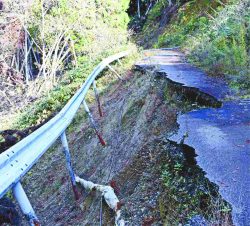
A Tohoku Shinkansen train is seen Thursday morning in Shiroishi, Miyagi Prefecture, after derailing during the previous night’s quake.
17:13 JST, March 17, 2022
A powerful earthquake measuring up to upper 6 on the Japanese seismic intensity scale from 0 to 7 struck off the coast of Fukushima late Wednesday night, leaving at least two dead and over 150 injured.
The magnitude-7.4 quake measured upper 6 in Tome and Zao in Miyagi Prefecture and in Soma, Minami-Soma and Kunimi in Fukushima Prefecture. The intensity reached upper 5 in Iwate and Yamagata prefectures and lower 5 in other areas of the Tohoku and nearby regions, while it was up to 4 in the Tokyo metropolitan area. The quake was felt even in Kyushu.
The Japan Meteorological Agency said the earthquake occurred at around 11:36 p.m. off Fukushima, with the focus estimated to be at a depth of 57 kilometers.

A man stands in front of a crumbled stone wall at the former site of the Sendai Castle in Sendai on Thursday. The wall collapsed in the earthquake that hit the Tohoku region late Wednesday night.
The agency believes that the latest earthquake’s epicenter was at almost the same location as the epicenter that caused the last earthquake in Japan to register upper 6, which took place on Feb. 13, 2021.
According to local authorities, a man in his 60s was found on the ground outside his home in Soma and later confirmed dead at the hospital, and a man in his 70s in Tome apparently died of shock.
At least 151 people had injuries connected to the quake across 11 prefectures, according to a Yomiuri Shimbun tally as of 9 a.m. Thursday.
There were also reports of the death in Miyagi Prefecture of a man in his 80s in Shiogama and a man in his 70s in Shichigahama. Police and other authorities are examining whether there are any connections between these deaths and the earthquake.
In the aftermath of the quake, the agency issued a tsunami advisory for Miyagi and Fukushima prefectures that was lifted at 5 a.m. Thursday. A 30-centimeter-high tsunami was observed in Ishinomaki, Miyagi Prefecture, and a 20-centimeter-high tsunami was confirmed in Sendai and Soma.

Two people sit around a heater at a shelter in Soma, Fukushima Prefecture, on Thursday morning after spending the night there. Tents were prepared for shelter users as a precautionary measure against COVID-19.
According to the Fire and Disaster Management Agency, evacuation orders were issued in 16 municipalities in Miyagi and Fukushima prefectures, but all were lifted by 9 a.m. Thursday.
The JMA said it had observed 19 earthquakes, believed to be aftershocks, through 10:30 a.m. Thursday, and advised residents of the affected areas to maintain vigilance, as a quake of up to an intensity of upper 6 may reoccur in the next week or so.
In Soma, hit by an upper 6 earthquake for two consecutive years, 188 residents evacuated to Sports Arena Soma. About 100 tents were set up there to prevent coronavirus infections and offer privacy to evacuees.
“Eleven years ago, the massive tsunami came close to our home,” said a 70-year-old man who lives over two kilometers from the coast, recalling the Great East Japan Earthquake of March 11, 2011.
He came to the evacuation center with his wife right after the shaking stopped.
“We’re afraid of aftershocks, too,” he said. “We wanted to evacuate as soon as possible.”

A residential area in Koto Ward, Tokyo, is partially blacked out after the earthquake on Wednesday night.
Shinkansen derails
According to East Japan Railway Co., the Yamabiko 223 train on the Tohoku Shinkansen line, traveling from Tokyo to Sendai, derailed between Fukushima and Shiroishi-Zao stations. No injuries were reported among the 75 passengers and three crew members, JR East said.
Operations were suspended between Nasu-Shiobara and Morioka stations on the Tohoku Shinkansen line, as well as on local JR lines in the Tohoku region.
Regarding Tohoku Shinkansen services, transport minister Tetsuo Saito said during a House of Councillors Budget Committee meeting on Thursday, “We’ve received reports that it could take a long time before services can be resumed, as damage has been confirmed to electric equipment and elevated tracks.”
Among the 11 expressways that were closed, cracks were found on the Tohoku, Tohoku-Chuo and Joban expressways, which were likely to remain closed for a while, according to the Land, Infrastructure, Transport and Tourism Ministry.

Items are seen scattered at a convenience store in Fukushima City following a powerful quake late on Wednesday.
In areas covered by Tohoku Electric Power Co., up to 150,000 households in five prefectures suffered power outages, and about 25,000 households in Miyagi and Fukushima prefectures were still without power as of 9 a.m. Thursday.
Up to 2.1 million households in Tokyo and eight other prefectures covered by Tokyo Electric Power Company Holdings, Inc. were also affected by power outages following the earthquake, but power was restored shortly thereafter.
A total of 5,727 households in Fukushima, Iwate and Miyagi prefectures were without water as of 9 a.m. Thursday, according to the Health, Labor and Welfare Ministry.
Tohoku Shinkansen
"Society" POPULAR ARTICLE
-

M4.9 Earthquake Hits Tokyo, Neighboring Prefectures
-

Israeli Tourists Refused Accommodation at Hotel in Japan’s Nagano Pref., Prompting Protest by Israeli Embassy and Probe by Prefecture
-

M7.5 Earthquake Hits Northern Japan; Tsunami Waves Observed in Hokkaido, Aomori and Iwate Prefectures
-

Tsukiji Market Urges Tourists to Avoid Visiting in Year-End
-

M5.7 Earthquake Hits Japan’s Kumamoto Pref., Measuring Upper 5 Intensity, No Tsunami Expected
JN ACCESS RANKING
-

Keidanren Chairman Yoshinobu Tsutsui Visits Kashiwazaki-Kariwa Nuclear Power Plant; Inspects New Emergency Safety System
-

Tokyo Economic Security Forum to Hold Inaugural Meeting Amid Tense Global Environment
-

Imports of Rare Earths from China Facing Delays, May Be Caused by Deterioration of Japan-China Relations
-

University of Tokyo Professor Discusses Japanese Economic Security in Interview Ahead of Forum
-

Japan Pulls out of Vietnam Nuclear Project, Complicating Hanoi’s Power Plans
























